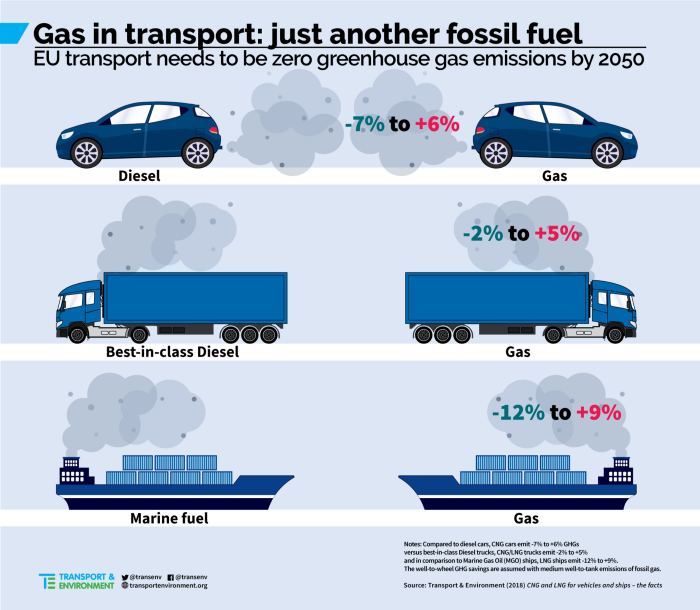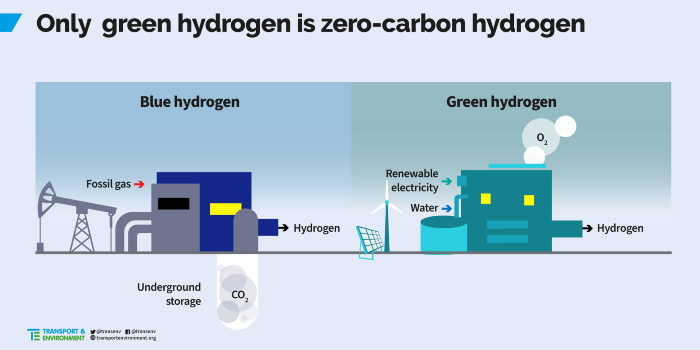Fossil gas — A dead end for the transport sector
by Laura Buffet, Transport & Environment

The recent announcement of a ‘carbon neutral’ LNG cargo by Total reveals a dodgy tactic to continue selling more fossil gas: relying on very dubious offsets to claim a ‘carbon neutral’ footprint. In the current climate emergency, we are likely to see even more of these greenwashing initiatives popping up, to make fossil gas look more acceptable. As a transport NGO, we have repeatedly demonstrated why fossil gas is a dead end for the transport sector. Ships and trucks are too often perceived as new markets where fossil gas has a major role to play, but this is simply not the case.
When looking at trucks, we have shown that LNG trucks can emit between two and five times more NOx emissions than diesel trucks. We’ve also recently revealed that vehicles using CNG (Compressed Natural Gas) also emit high levels of toxic pollutants, such as particles and ultrafine particles. And a recent ICCT study pushed back against the claims that LNG trucks would be beneficial for the climate. It points out that under a 20-year timeframe, “LNG trucks are invariably worse than diesel, due to the strong short-term climate impact of methane”.

In the case of LNG for ships, the picture is not really different. Several studies, including a 2020 study by the International Council on Clean Transportation (ICCT) have shown that LNG ships have a similar or worse climate footprint than conventional ships using Marine Gas Oil. At least, LNG here presents benefits in terms of air pollution. However, similar emissions performance can also be achieved by equipping ships with after treatment systems and using low sulphur fuel.
So what would be the purpose of building new LNG infrastructure and new LNG trucks and ships if these do not bring significant benefits to the climate? They would just enable gas companies to sell more fossil gas! But why is the gas industry so desperate to sell gas in transport even though there are no real benefits? Dwindling demand in their key markets in electricity and heating and the overall decarbonization imperative are the key reasons that there is no real future for gas companies, unless they could find new growth markets for their product.
Now, a new gas threat is emerging in Europe, driven by a major push for a hydrogen-based economy. Its name is ‘blue’ hydrogen. Don’t be fooled by the nice neutral association conjured up by the colour. Blue hydrogen is nothing more than hydrogen produced from fossil gas, combined with carbon capture and storage (CCS). Despite calls by civil society to exclude it, the European Commission kept the door open for this fossil-based hydrogen in its EU hydrogen strategy published in July. Even if the strategy focuses much more on green hydrogen produced from renewables, the gas lobby managed to get its way. The EU strategy basically adhered to Shell’s vision that ‘blue hydrogen will help provide the scale and cost-effective approach needed to start decarbonizing hard-to-abate sectors’. It eventually buys more time for the use of fossil gas under a new, blue umbrella and with an official ‘low carbon’ label. “Blue hydrogen” is the latest incarnation of the idea of adding carbon capture and storage (CCS) on top of the “normal” process of converting fossil gas into another energy carrier. The coal industry used to call it “clean coal”. After decades of industry calling for subsidies to make it work, CCS still isn’t moving at scale and is unlikely to beat the renewable competitor technologies. Cost reductions in renewable power and the learning effects generated by deploying electrolysers will close the price gap between green and blue hydrogen over the next decade.

The transport sector will need green hydrogen for decarbonising long-distance shipping and for producing electrofuels to decrease emissions in the aviation sector, but this hydrogen shouldn’t be based on fossil gas. The good news is that the EU hydrogen strategy does not set everything in stone. More discussions will take place on the issue at country level and also between EU institutions.
At national level, many countries have favourable measures in place, including tax breaks, for gas in transport but they can decide to end this. For example, the Spanish government announced a new ‘scrappage’ scheme but excluded gas powered cars from the category of ‘low-emission’ replacement vehicles. The gas industry challenged that proposal but Spain’s highest courts ruled in favour of the measure. At EU level, key measures are also in the making. Early next year, the EU Commission will, for instance, propose a new law on alternative fuels in shipping. Under this new initiative, LNG ships could get a green light — this should be avoided at all costs.
We call on all concerned citizens and EU policy-makers to disqualify LNG and all fossil gas based fuels, including blue hydrogen, from our future transport system and from our decarbonised economies. So if you’re thinking about purchasing a new car, don’t get tricked into buying a gas powered car and thinking you will cause less pollution. And if you want to add your voice to the 1.3 million EU citizens who asked for EU recovery plans not to support polluting industries, including fossil gas, you can sign the call here.
Shifting to renewable, zero emissions technologies as soon as possible is the only path to save us from an even more extreme climate crisis, not more fossil gas in transport. Let’s not get stuck in this dead end road.
